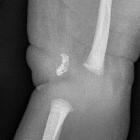Luxation Kniegelenk
Knee dislocations are rare, but a significant number have a serious associated neurovascular injury. This article discusses the tibiofemoral joint dislocation. Please see separate articles for discussion of medial and lateral patellar dislocations.
Epidemiology
They account for <0.5% of all joint dislocations. Knee dislocations are bilateral in 5% of cases .
Clinical presentation
Dislocation of the knee is usually obvious clinically with a marked deformity. It is seen in the context of both high and low energy trauma. There is a high risk of neurovascular sequelae and therefore rapid assessment and definitive treatment is essential.
Complications
- damage to the popliteal artery occurs in ~30% (range 20-30%)
- nerve damage is reported in ~30% (range 16-40%) with the common peroneal nerve more commonly injured than the tibial nerve
Pathology
Five types of knee dislocation have been described, with respect to tibial displacement compared to the femur :
- anterior (40%)
- due to hyperextension injury
- usually involves a tear of PCL
- an arterial injury is generally an intimal tear due to traction
- posterior (~33%)
- due to axial load to the flexed knee (dashboard injury)
- the highest rate of vascular injury (25%)
- the highest rate of a complete tear of the popliteal artery
- lateral (~20%)
- due to a varus or valgus force
- usually involves tears of both ACL and PCL
- the highest rate of peroneal nerve injury
- rotatory (~5%)
- posterolateral is most common rotational dislocation
- usually irreducible
- buttonholing of femoral condyle through the capsule
- medial (~5%)
- varus or valgus force
- usually disrupted posterolateral corner and PCL
Knee dislocations are invariably associated with ligamentous injuries. The most common pattern is bicruciate (i.e. both anterior and posterior) cruciate ligament tears with either medial collateral ligament tear or posterolateral corner injury . Fractures of the distal femur or proximal tibia are also common (~15%) .
Mechanism
Forced hyperextension is the most common mechanism of injury, and can occur in both high-velocity (e.g. motor vehicle collisions) and low-velocity (e.g. sports injuries) trauma.
Classification
The Schenck classification categorizes knee dislocation based on the pattern of multiligamentous injury and is the usual system used by sports medicine physicians; it has superseded the older position (Kennedy) classification system. Trauma surgeons tend to use a different classification based on the energy and velocity of the trauma .
Treatment and prognosis
The management of dislocations in the emergency department firstly requires immediate reduction of the knee joint, ideally as a closed procedure. A rapid neurovascular assessment is then performed. In posterolateral dislocations, a closed reduction may be impossible, in which case an open reduction is necessary .
Once the knee joint has been relocated, further management depends on the age and activity of the patient. Generally, a non-interventionist rehabilitation is advocated in those who are more sedentary, or of advancing age. The mainstay of this approach is immobilization. Although this may lead to a stable joint, mild dysfunction is often a problem. Thus a conservative approach is generally not felt to be appropriate in younger, more active individuals.
Therefore surgical intervention is now advocated for this latter cohort, with usually better functional outcomes. The main criterion for surgical repair rests on the severity of ligamentous injury .
Siehe auch:
und weiter:

 Assoziationen und Differentialdiagnosen zu Luxation Kniegelenk:
Assoziationen und Differentialdiagnosen zu Luxation Kniegelenk:
